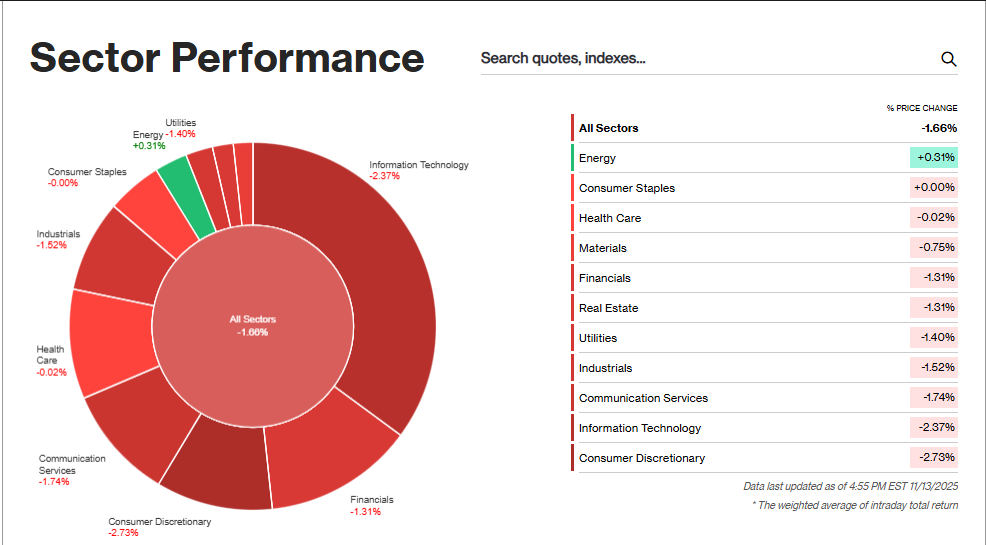Asian Shares Today, Nov 14: Markets Slide on AI Stock Fears and Rising Interest Rates
Asian shares in the market faced a tough start on November 14, 2025, as worries around AI stocks and rising interest rates sent investors into caution mode. The mood turned tense early in the day. Traders watched tech shares drop across the region. Many feared that the fast growth in AI might slow after new warnings from major chipmakers. This created fresh doubt about how strong the sector can stay in the coming months.
At the same time, bond yields climbed again. This pushed markets to rethink hopes for early rate cuts. Higher borrowing costs usually hurt growth stocks, and tech companies felt the pressure first. The mix of AI concerns and rate fears hit key markets in Japan, China, and South Korea. It also weighed on smaller markets in Southeast Asia.
Investors now want clear signs that the AI industry will stay strong and that global rates will stabilize. Until then, market mood may stay shaky. Today’s trading session shows how fast sentiment can shift when two major fears collide.
Asian Shares: Market Overview
Tokyo, Seoul, Shanghai, and Hong Kong all traded lower on November 14, 2025. Tech-led losses weighed on major indices. South Korea’s Kospi and Japan’s Nikkei were among the hardest hit. Markets moved in step with a sharp sell-off on Wall Street. The regional slide reflected two big worries: fear that AI stock gains have outpaced reality, and rising U.S. bond yields that dim hopes for quick rate cuts.

In Japan, the Nikkei fell as chip and electronics names slid. Currency moves also mattered. A weaker yen made some investors nervous about profit margins and capital flows. In China, the Shanghai Composite and the Hang Seng dropped after mixed economic data and renewed caution around large tech firms. Taiwan’s Taiex and South Korea’s tech-heavy markets saw steep losses in major semiconductor names.
Smaller markets in Southeast Asia followed the trend. Singapore, Indonesia, and Thailand traded down. Foreign flows turned negative across much of the region. That pulled liquidity away from local stocks and pushed yields higher in regional bond markets.
AI Stock Fears: What Triggered the Sell-Off?
The first trigger was soft guidance and cooling growth signals from chip suppliers. Investors reacted to reports that some foundry and equipment firms showed slower demand than expected. Slower chip orders raised doubt about the pace of enterprise AI spending.
Second, high valuations fed anxiety. Many AI-linked firms carry lofty price tags. That leaves them vulnerable when sentiment shifts. Traders saw recent gains as fragile. They used the pullback to take profits. Analysts likened parts of the rally to classic speculative episodes.
Third, regulatory and policy talk added friction. Draft rules and tougher data policies in parts of Asia have increased uncertainty for AI projects. Firms that train large models often depend on cross-border data flows. Any new limits could slow deployments and raise costs. Together, these forces pushed tech-heavy indexes lower.
Interest Rate Pressures Return
U.S. Treasury yields climbed in the lead-up to November 14. Hawkish commentary from Fed officials reduced the odds of a near-term rate cut. This shift raised the cost of capital worldwide. Higher yields hit growth stocks first. The 10-year U.S. yield rose enough to force portfolio rebalancing.
Asia felt that move in two ways. First, higher U.S. yields dented risk appetite. Second, local central banks reacted by keeping policy tight for now or delaying easing plans. The Bank of Korea and other regional banks signalled caution in recent weeks. That stance removed the safety net many investors had hoped would cushion markets.
Currency swings amplified the pain. The yen and won slid against the dollar at times. A weaker local currency often spurs capital outflows. Those outflows further pressured equities. In short, the rising global yield backdrop made growth assets less appealing.
Sector-Wise Performance Today
Technology led to losses. Semiconductor stocks and cloud-related names saw the steepest declines. Chipmakers such as TSMC and South Korea’s memory firms reported slower growth signals. That added fuel to the negative cycle.

Financials had mixed results. Banks gained in markets where yields rose. Higher yields can lift net interest margins. Yet, credit concerns and softer loan demand in some economies kept gains muted. Consumer and retail names generally underperformed. Rising yields and shaky confidence weighed on spending forecasts. Energy and basic materials posted patchy moves as oil prices found some support but lacked a clear trend.
Investor Reactions and Expert Views
Traders shifted toward safer assets. Gold, cash positions, and short-term government securities saw increased demand. Portfolio managers trimmed exposure to lofty growth stocks. Some funds are locked in gains from the AI rally. Others waited for clearer signs of sustained corporate spending on AI projects. Analysts stressed the need to watch earnings and order books for confirmation that the AI boom remains durable.
A number of institutional analysts used an AI tool to re-run demand scenarios for data center chips and cloud services. Their models produced more conservative revenue paths for 2026 than earlier forecasts. That conservative tilt fed caution among global asset managers.
Global Market Influence
Wall Street’s volatility drove much of the Asian reaction. U.S. tech weakness in the Nasdaq and a drop in marquee AI stocks set the tone. European futures also suggested a cautious opening. The stronger dollar and higher bond yields constrained cross-border risk-taking. In this environment, news from the U.S. and earnings from major tech firms will likely dictate short-term trends.
Outlook for the Coming Days
Markets may stay volatile in the near term. Investors will watch upcoming earnings reports from major chipmakers and cloud providers. Any evidence of renewed AI spending could calm nerves. Conversely, further hawkish signals from Fed officials would likely deepen the sell-off. Economic data from China and corporate guidance will be key. Until clearer signals emerge, risk appetite is likely to stay subdued.
Closing Note
On November 14, 2025, Asian shares fell under twin pressures. AI sector doubts and rising yields pushed traders to reassess risk. Short-term volatility seems likely. The path forward depends on data and corporate news. Markets will respond quickly to any sign that AI demand is real and that interest-rate hopes are alive.
Frequently Asked Questions (FAQs)
Asian shares fell on November 14, 2025, because investors worried about slower AI growth and higher interest rates. Tech stocks dropped first, and weak global signals added more pressure.
Higher rates make borrowing costly and lower the value of future profits. Tech and AI stocks react fast to this, so many investors choose safer assets instead.
Experts say AI chip demand may improve later in 2025, but trends still depend on global spending, new products, and company earnings. Markets will move with these updates.
Disclaimer: The content shared by Meyka AI PTY LTD is solely for research and informational purposes. Meyka is not a financial advisory service, and the information provided should not be considered investment or trading advice.






